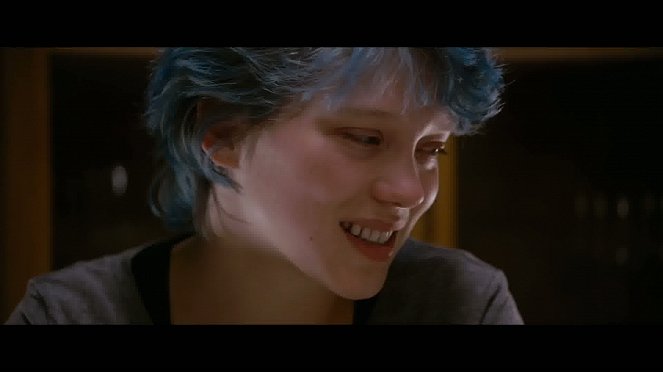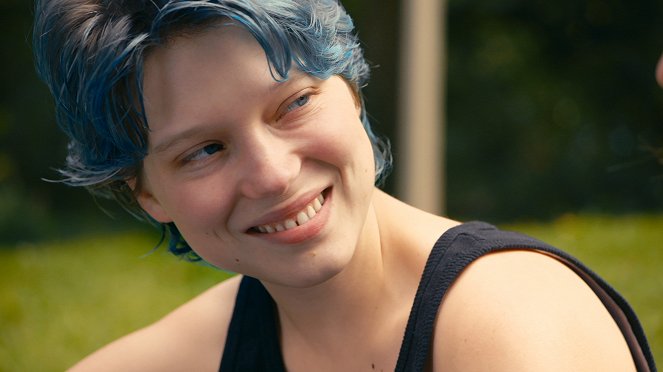Réalisation:
Abdellatif KechichePhotographie:
Sofian El FaniActeurs·trices:
Adèle Exarchopoulos, Léa Seydoux, Salim Kechiouche, Jeremie Laheurte, Catherine Salée, Aurélien Recoing, Benjamin Siksou, Alma Jodorowsky (plus)VOD (3)
Résumés(1)
À 15 ans, Adèle ne se pose pas de question : une fille, ça sort avec des garçons. Sa vie bascule le jour où elle rencontre Emma, une jeune femme aux cheveux bleus, qui lui fait découvrir le désir et lui permettra de s'affirmer en tant que femme et adulte. Face au regard des autres Adèle grandit, se cherche, se perd, se trouve... (Wild Bunch Distribution)
(plus)Vidéo (3)
Critiques (10)
Être un jeune couple hétéro, c'est banal et insignifiant. Être deux garçons gays, c'est insupportable pour la majorité des spectateurs. Il s'agit de deux lesbiennes et le jury de Cannes, dirigé par le roi d'Hollywood, leur décerne la Palme d'Or. Le film de trois heures, "La Vie d'Adèle", raconte lentement et pas trop dramatiquement les choses de la vie quotidienne, tout comme le film de trois heures de Linklater, "Boyhood". Mais contrairement à "Boyhood", il se concentre sur une période spécifique de la vie du personnage principal avec une telle profondeur que cela nous conduit aux larmes dans la dernière phase de son histoire. Parce que nous savons tous combien cela fait mal, peu importe notre orientation sexuelle. Les scènes sexuelles sont très ouvertes, mais pas gratuites. Au contraire, elles sont très importantes pour l'assimilation physique et émotionnelle de l'histoire, qui en est l'alpha et l'oméga. Le duo central de jeunes actrices joue de manière incroyable. Chaque mot, chaque sentiment, chaque regard.
()
Défi ciné 2018 : les pays de mon TOP 10. La Vie d’Adèle contient à peu près tout ce que j’aime dans la France et les films français. Un film incroyablement beau, émouvant, coloré et prenant. Il contient une série de scènes longues et inoubliables qui me resteront longtemps en mémoire, notamment le dîner familial aux huîtres, la dispute, la scène au bar et la fête d’anniversaire. Puis, Lykke Li et son Follow the rivers est littéralement l'hymne du film ; on n’aurait pas pu trouver mieux comme chanson thème. Adèle Exarchopoulos est super mignonne, comme on l’entend dans le film, et puis surtout, sa prestation est absolument sublime – une révélation comme avec Marina Vacth. Quant à Léa, elle ne déçoit pas, même en tant qu’actrice formée à Hollywood et parée de sa courte chevelure bleue. Pour ma part, j'aurais pu facilement tenir six heures avec une histoire pareille, alors que je ne suis généralement pas friand de longs films. Longue vie à Cannes !
()
The problem isn’t in its (justified) enormous length, but it should have taken a break between chapters 1 and 2. A good few years too, to let Adele grow up, because it seems quite out of place when, in the second phase, the scarcely twenty-year-old girl plays a middle aged woman and all that was different from her teenage phase were the glasses. Another problem are the explicit sex scenes; how they were performed didn’t fit with the mood of the movie. More than anything else, it seems like Kechiche wanted to quench his thirst for slapping young meat on set. Paradoxically, the best bed scene was the dialog after the garden party. And not least is the problematic closing twenty minutes when it gradually fizzles out in a way quite unfair to the qualities of the rest of the movie. These difficulties still don’t outweigh the fact that there are still entire passages (enough to make a long feature movie) when the story of Adele and Emma’s relationship is unrivalled in authenticity, drawing the viewer through all of the good and bad emotions that are integral to any relationship. P.S.: If you are racking your brains about the role of the diary that there so much secret and important talk about, but then nothing (not even the MacGuffin), so I recommend finding out what work this is based on and what the narrative style the original is.
()
Blue Is the Warmest Colour takes a complex approach to depicting several developmental phases in the life of a girl who is becoming a woman. Kechiche could have shown only cause, effect and consequence, but he is more interested in the process and the course of the transformation itself, as well as its duration. Length is one of the many tools that the director uses to break down the barrier between the movie 90 protagonist, Adele, and the viewer. ___ A good eighty percent of the dialogue (and thus of the whole film) is handled through close-ups of faces. The traditionally rendered dialogue scenes consistently reassure us that reality continues outside the frame of the picture. Conversely, we are given the impression of being enclosed in a small space that is more or less defined only by the actors’ bodies. Ignoring the surrounding environment intensifies our connection with the characters, whose intimate zone limits what we see and hear. The distancing of the camera from the character at the end of a dialogue scene then serves as a liberating means of stepping out of the inner universe of interpersonal relationships and into the outside world. Whether the characters’ communication, be it verbal or non-verbal (including sex), is conveyed using the shot/countershot technique or through panning, also plays a role. However random it may seem, the form is always under the director’s control, fully subordinated to the process of bringing the characters together and distancing them both physically and mentally. ___ In multiple senses, a line is crossed during the erotic scenes (love and sex, reality and pretence), each instance of which has its own justification (for example, the sharp contrast between a moment of extreme intimacy and the following scene of a family birthday party, which requires far more pretence). The explicitness of the erotic scenes raises legitimate suspicion of voyeurism on the part of a tyrannical director (whom both actresses have described as a genius, though they no longer want to work with him), while their unusual length is the most extreme expression of the film’s unwillingness to pretend anything in communicating with the viewer. It is no coincidence that Blue Is the Warmest Colour also addresses the limits of honesty of representation (whether in film or in other arts) in dialogue that never descends into café blather that would only serve to demonstrate the filmmaker’s intellectual prowess. References to films such as Pabst’s Pandora’s Box reasonably complement the main motifs of the narrative and concurrently help us to understand the characters outside of the relationship context. ___ I don’t know of many films that could go this deeply and with such physical urgency under the skin of the main character. In my case, the idea of “putting yourself in someone else’s shoes” was manifested with extraordinary intensity. After three hours, I was glad to start living my own life again, but my connection with Adele definitely did not end with the closing credits. 85%
()
(moins)
(plus)
I’ll be honest, I was afraid of this. My subjective viewer experience was terrified of a three-hour long French lesbian art film, and I believed that not even the fact that it will probably be a very good three-hour long French lesbian art film would help. But the fears were unwarranted, the film gripped me from the beginning and didn’t let me go until the end. Fantastic performances, incredibly firm direction; a thrilling experience. I wouldn’t cut a single minute of it, every scene in Blue is the Warmest Colour makes sense.
()



Annonces